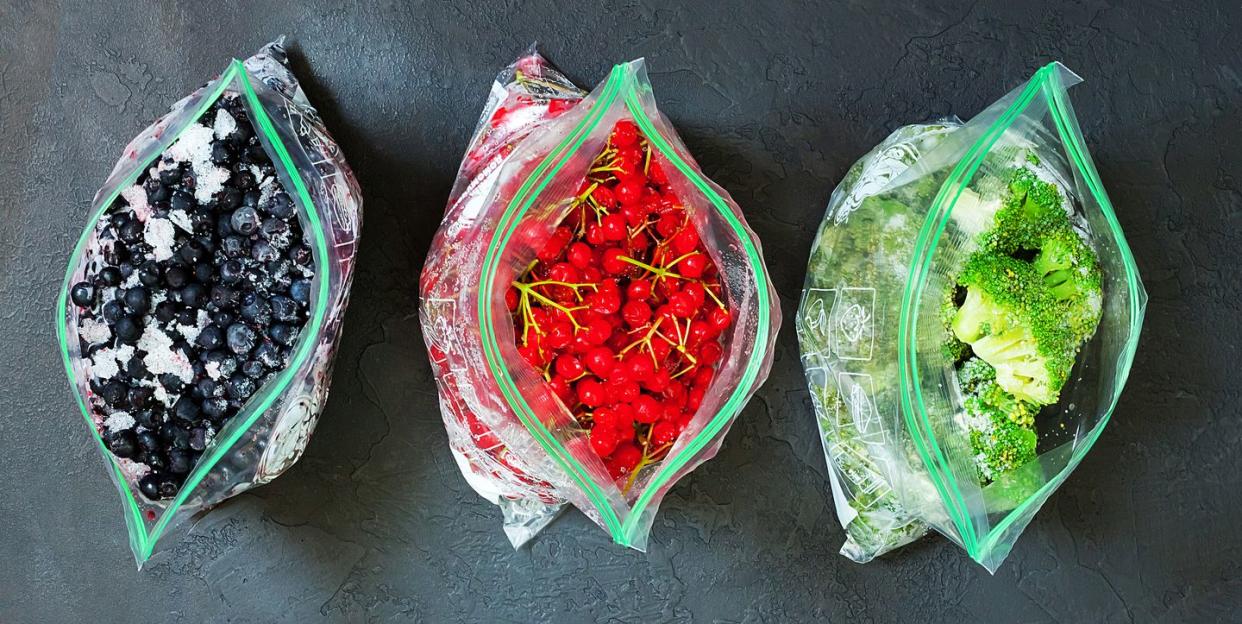Got Frozen Fruits and Vegetables Over 12 Months Old? It Might Be Time to Replace Them

“Hearst Magazines and Verizon Media may earn commission or revenue on some items through the links below.”
Stocking up a bit more than usual on essentials is part of the new normal these days, and that might include a few mini-towers of canned goods or frozen food options.
Fruits and vegetables that are commercially frozen are just as nutritious as their fresh counterparts, and sometimes even more so, according to Terry Wahls, M.D., clinical professor of medicine at the University of Iowa. That’s because produce starts to lose vitamins and minerals gradually after harvest, so the longer it takes to travel from field to fork, the less nutrient-dense it becomes, she tells Runner’s World. But freezing pauses this process, so you can get an abundance of the good stuff.
Wahls’ preference is recently harvested, local, seasonal, organic produce, but she acknowledges that’s not always easy to find—especially when you’re not shopping as often.
“Frozen foods are a good, affordable way to eat more quality foods like vegetables,” she says. “What I’ve seen is that people are very successful at making radical changes when faced with radical circumstances. Obviously, that’s what’s happening right now, so it’s an opportunity to change your diet to be healthier—and frozen foods can make that easier.”
Plus, as long as freezer temperatures are 0-degrees Fahrenheit or below, it brings bacterial growth to a complete stop, versus fridge temps, which only slow down that growth, according to Janilyn Hutchings, certified food safety professional and food scientist at StateFoodSafety, a food safety certification and training program for the hospitality industry.
“Technically, food that’s been kept frozen is safe to eat indefinitely,” she says. “However, the longer it stays frozen, the more quality tends to decrease, including changes in taste and texture so there are exceptions to the ‘indefinite’ rule.”
Here’s a look at how long items can be stashed before they need to be trashed.
Fruits and Vegetables
In general, fruits and vegetables can be frozen for eight to 12 months before they deteriorate in quality, Hutchings says. But this is also where the exception to “indefinitely edible” comes in.
“Although freezing does stop bacterial growth, it doesn’t stop enzyme activity in foods with low acidity, like vegetables,” she says. “Enzyme activity contributes to decreased quality of frozen vegetables.”
For best results, if you’re trying to freeze fresh vegetables on your own—not buying bags of commercially processed frozen vegetables—you should blanch them before freezing, said Hutchings. According to the National Center for Home Food Preservation, this stops enzyme action, and also slows loss of vitamins. Blanching time varies with vegetable type and size, so check out the organization’s site for advice.
Meats
If you’re planning to freeze meat, Hutchings suggests opting for raw meat over cooked because that helps it retain its quality longer.
Raw beef, veal, lamb, and pork is typically good for four to 12 months, she says, while raw ground meats are good for three to four months. Raw poultry sticks around longer, at nine to 12 months. By contrast, cooked meats are usually good for just two to six months, Hutchings says.
The reason ground meats have a shorter timeframe is because there’s a higher chance of bacteria exposure because of the way it’s processed and handled, William Li, M.D., physician, scientist, and author of Eat to Beat Disease says.Additionally, he recommends making sure to smell any meat once it’s thawed, because if the aroma is off, that’s a sign it’s no longer safe to eat.
Fish
When it comes to keeping its quality, fish should be in a more frequent rotation in your freezer lineup—it’s good for just three to six months.
“Seafood is highly perishable, and how it’s handled and packed can make a big difference in its longevity in your freezer,” says Li. “Commercially caught fish and shellfish, flash frozen on the boat at sea, is usually vacuum sealed and safe to keep for six months, although the flavor may go stale.”
Even mild thawing can shorten a fish’s freshness, he adds, so it’s important to keep frozen seafood completely frozen. That means if it’s a bit of a haul to the grocery store for you, it may be worth bringing a cooler with ice packs to ensure your fish stays at the right temperature.
[The Beginner’s Guide to Strength Training will teach you all the fundamentals to get the most out of your weight session.]
Precooked Meals and Leftovers
Whether you make them at home, have leftovers from a restaurant, or buy commercially prepared meals, all precooked meals are typically good for one to two months, Hutchins says.
If you’re storing leftovers, Li adds that it’s important to use clean utensils and storage containers, to avoid trapping bacteria in with the food.
How to Tell If Food Has Gone Bad
As a food cools down, water molecules turn into ice, and if there’s air in the container or around the food, these find their way to the surface of the food. This can cause color changes or texture issues, especially as it thaws, and it’s considered “freezer burn,” Hutchings says.
“Freezer burn is an indication that the food’s quality has been compromised,” she says. “The food is still usable as long as you cut away the ‘burned’ portions, which are often gray, leathery spots. But if there’s a lot of freezer burn, it’s usually best to just throw it away.”
One last tip: Start marking the date on each item, using the guidelines above. Simply indicating the date you froze it isn’t as helpful as creating a “use by” date on the package.
You Might Also Like

